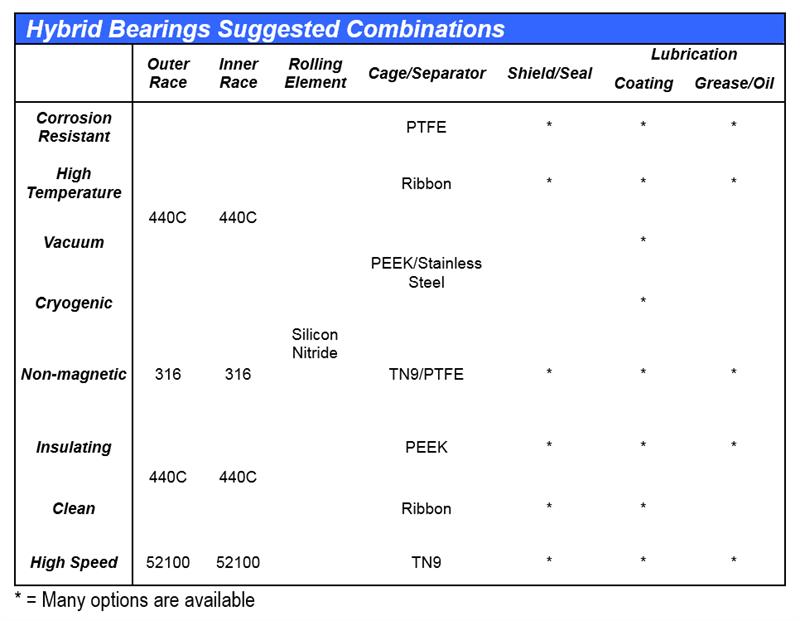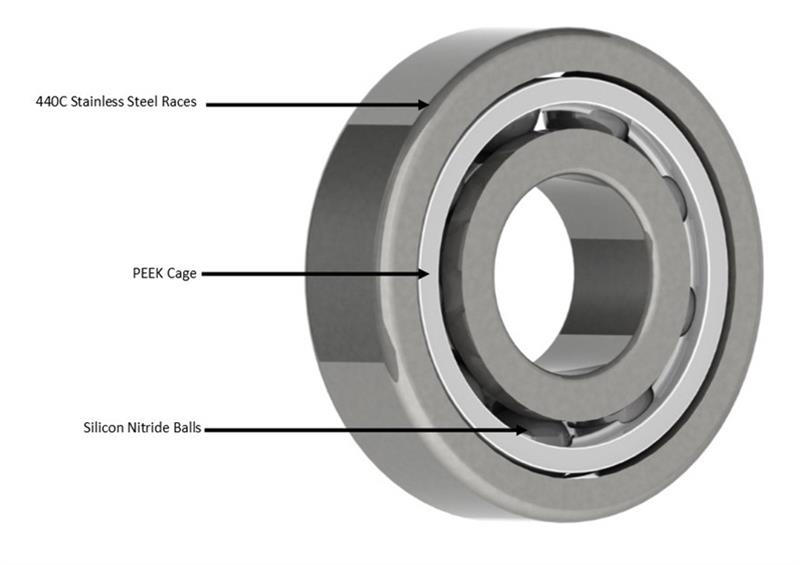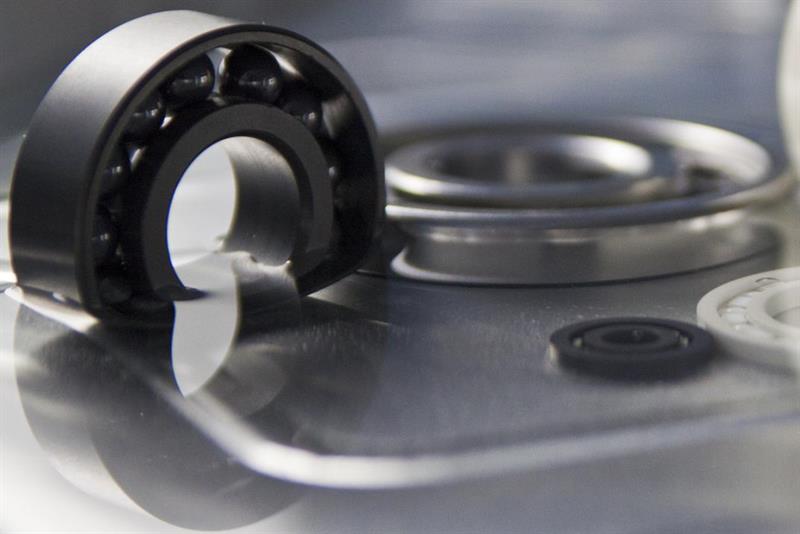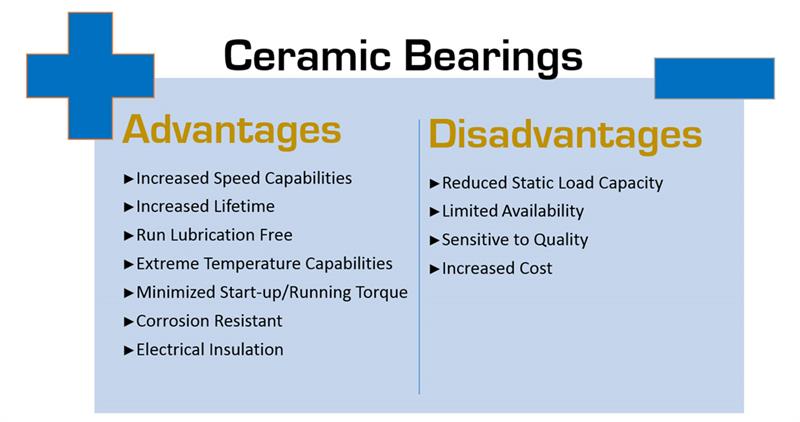We will discuss the advantages and disadvantages of hybrid bearings followed by some specialist dry film lubrications and end with a few interesting examples of cutting-edge applications already using hybrid bearings.
Let us begin by defining the terms hybrid bearings versus ceramic bearings. For the purposes of this article, hybrid bearings are defined as a composite assembly of metallic rings and ceramic rolling elements while ceramic bearings have both ceramic rings and ceramic rolling elements.
Here are a few common hybrid bearing configurations:

Figure 1: A table of hybrid bearing suggested combinations
All suggestions are subject to each individual application and are for comparative use only, in order to suggest the correct specification please contact one of our Engineers.
Hybrid bearings have many advantages that set them apart from conventional steel bearings; however, there is also a disadvantage or two. We’ll start with the advantages.

Figure 2: CAD render of hybrid angular contact bearing for a cryogenic pump
Advantages
Increased Speed Capabilities
•Silicon nitride is 58% less dense than conventional bearing steel which minimises the centrifugal forces acting on the raceway as the ceramic balls rotate. This increases the speed capabilities by 20-50%.
Applications: Motorsport, Machine Tool Spindles, Turbomachinery and Dental Drills.
Increased Lifetime
•Silicon nitride is roughly two times harder than standard bearing steel. This causes the ceramic balls to polish the metallic raceway as it rotates creating a smoother running surface thus prolonging lifetime.
Applications: any application trying to maximise service life.
Run Lubrication Free
•Hybrid bearings are able to run lubrication free as the interaction between steel and ceramic do not induce micro-welds.
Applications: Ultra High Vacuum, Cryogenic, Space/Aerospace, Scientific Instrumentation and Chemical/Medical.
Extreme Temperature Capabilities
•Cryogenic temperatures, -273⁰C, are achieved due to silicon nitrides low thermal expansion coefficient and ability to run without lubrication.
Applications: Cryogenics, Scientific Instrumentation and Space.
•Hybrid bearings with full complement construction and specialist high temperature alloys such as BG-42 can achieve temperatures of up to 900⁰F (482⁰C).
Applications: Gas Turbines, Jet Propulsion and Exhaust Butterfly Valves.
Minimised Start-up/Running Torque
•Hybrid bearings don't require lubrication, are harder and have lower inertia than conventional bearings. This minimises the start-up and running torque allowing the bearings to initiate and sustain rotation effortlessly.
Applications: Scientific Instrumentation, Paper Mill and Piezoelectric Motor.
Corrosion Resistance
•When paired with stainless steel or a Unasis XtraChrome coated races, hybrid bearings can provide vastly superior corrosion resistance. Hybrid bearings using Cronidur 30 races exhibit extreme corrosion resistance without compromising on hardness unlike 316 Stainless Steel.
Applications: Offshore, Ultra High Vacuum, Cryogenic and Food Processing.
Electrical Insulation
•Ceramic materials impede the electrical current through the bearing which makes hybrid bearings ideal for applications requiring electrical insulation.
Applications: Electric Motors and Scientific Instrumentation.

Figure 3: Examples of hybrid and ceramic bearings
Disadvantages
Reduced Static Load Capacity
•Due to the brittle characteristics of ceramic materials, the static load capacity is reduced by about 30% from the conventional steel equivalent while the dynamic load rating remains the same.
Limited Availability
•Hybrid bearings are highly specialised bearings and because of this, the supply chain is minimal. It is important to have a trustworthy supplier with a large investment in high quality stock such as Carter Manufacturing Limited.
Sensitive to Quality
•Ceramics, as a material, are brittle and therefore sensitive to cracks, flaws and contamination from manufacturing. Manufacturing ceramic balls requires technical expertise and rigorous quality control. It is important to know that your hybrid bearings come from a reputable source to prevent premature failure.
Cater Manufacturing Limited is the European master distributor for Napoleon Engineering Services, the premium manufacturer of custom hybrid bearings from the USA which run small volumes with full aerospace certification AS9100 for flight critical bearings.
Increased Cost
•Hybrid bearings are more expensive than their standard steel bearing equivalents. However, in general, they are much cheaper than ceramic bearings. Carter is a highly competitive supplier that doesn't compromise on availability, quality or technical expertise.

Figure 4: A table of the advantages and disadvantages of hybrid bearings
Dry Film Lubrications
Hybrid bearings are capable of running lube-dry but that doesn't mean they don't benefit from specialist dry film lubrications such as: Unasis XtrMD Coating, XtraTD Coating and XtraChrome Coating.
XtrMD Coating
Unasis XtrMD coating is a Molybdenum Disulphide based coating that can be applied to a variety of components.Molybdenum Disulphide (MoS2) is a naturally mined inorganic material that has become extremely popular as a dry film lubricant due to its availability, price and advantages over comparable dry film lubricants. Unais XtrMD coating acts as a sacrificial lubricant which increases the bearing life by reducing the coefficient of friction and increasing the speed capability.
XtraTD Coating
Heavier and more stable than Molybdenum Disulphide, Tungsten Disulphide has been extensively used throughout a number of NASA, military and aerospace applications. With an even lower friction coefficient than Molybdenum Disulphide and the ability to slow corrosion in some materials, Tungsten Disulphide is a preferred coating in extreme environments. It can be used as a solution to problems such as excessive wear, seizing, galling and fretting. The coating itself is only 0.5 microns thick and will not bond to itself, negating build up.
XtraChrome Coating
XtrChrome is a nodular thin dense chrome coating applied to the bearing components in a process that ensures precise coating deposition. The process offers many advantages including superior corrosion resistance, increased surface hardness (78 HRC), increased bearing life, cost reduction, reduced production lead time and energy saving properties due to reduced surface friction compared to conventional bearing stainless steel.
Applications
Ultra High Vacuum
Ultra high vacuum applications require components with minimal outgassing properties in order to efficiently draw and sustain a vacuum. The hybrid configuration is ideal as they can run lubrication free with vacuum compatible dry film lubrications. The most popular vacuum compatible configuration is 440C stainless steel races, silicon nitride balls and a stainless steel or PEEK cage. PEEK, polyether ether ketone, is an organic thermoplastic polymer made popular by its stiffness and temperature stability in extreme environments. This configuration is utilised in many deposition stages, mass spectrometers and multi-stage goniometers among many others.
Cryogenic
At extreme temperatures, cryogenic applications demand the most of their bearings. Silicon nitride has a significantly lower thermal expansion coefficient than steel which allows the balls to retain their shape and rolling dynamics while running lubrication free. Fits and tolerances are of critical importance when dealing with thermal expansion and contraction. Most cryogenic applications utilise stainless steel for their bearing housing material which matches with hybrid bearings in terms of thermal expansion. Carter’s expertise will provide confidence and security for applications like cryogenic pumps, rotatory joint for a liquid nitrogen couplings and cryogenically cooled tool spindles.
Electric Motors
Hybrid bearings have proved to be exceedingly popular in electric motor applications. In particular, the growing wind energy market has seen major benefit in the use of hybrid bearings. Issues arise in electric motor bearings when an electrical current is passed through the bearing causing electrical pitting. The current will cause arcing to occur between the race and ball leading to dramatically increased wear, noise and lubricant degradation. Once this has occurred the bearing has to be replaced.
Due to the insulating properties of ceramic materials, hybrid bearings do not allow the current to be passed between the races, thus overcoming all the electrical pitting issues found with conventional steel bearings. This coupled with the additional benefits such as longer life and higher speed capacity of hybrid bearings, means that electrical motors have been revolutionised.
Conclusion
Hybrid bearings have proven to have substantial benefits for many industries. Their increased speed capabilities, increased lifetime, ability to run lubrication free, minimised start-up and running torque, corrosion resistance and electrical insulation provide solutions to many extreme environment applications. Although there is a reduction in static load capacity, limitation of availability, sensitively to quality and increased cost, the advantages dwarf the disadvantages. In many applications when combined with dry film lubrications like Unasis XtrMD, Unasis XtraTD and Unasis XtraChrome coatings, hybrid bearings can drastically improve speed ratings, lifetime, hardness and corrosion resistance. These combinations have been tested and evaluated in many industries including ultra high vacuum, cryogenic and electric motors among many others.
If you find yourself in a situation where your bearings are not performing to the standard you desire, hybrid bearings could be the solution. Please contact Carter Manufacturing Limited with details of your application and our experts will advise the best bearing solution for you.











